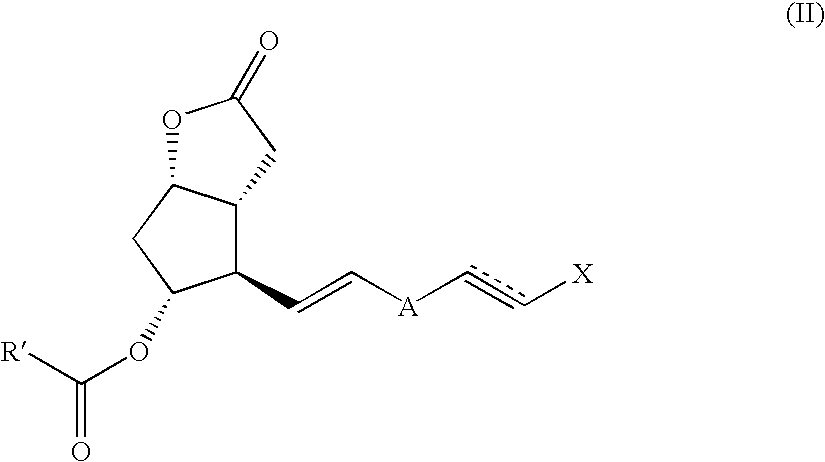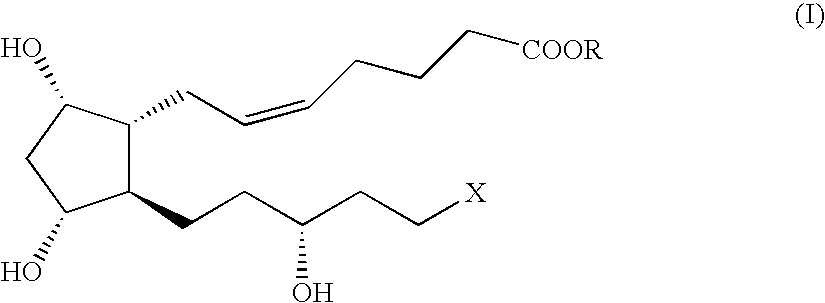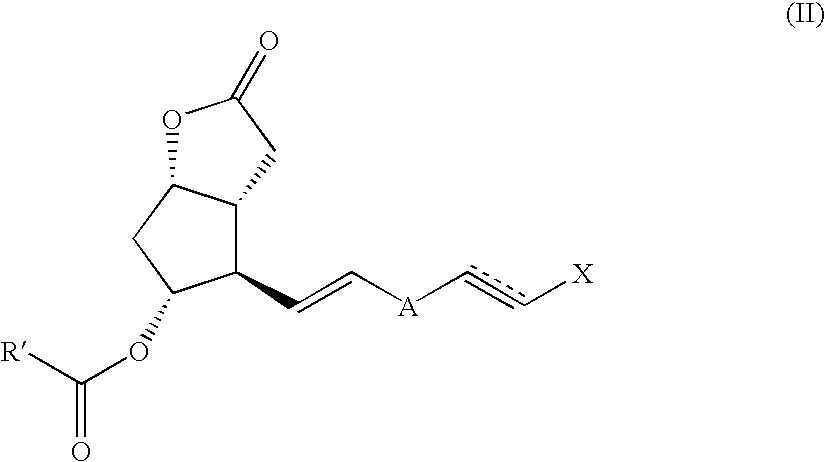Method and intermediate for preparing a prostaglandin F-type compound
a prostaglandin and compound technology, applied in the field of preparation of prostaglandin f-type compound, can solve the problems of eyeball tissue damage, vision loss, optic nerve damage,
- Summary
- Abstract
- Description
- Claims
- Application Information
AI Technical Summary
Benefits of technology
Problems solved by technology
Method used
Image
Examples
example 1
[0050]
[0051] Formula (IX-1) compound (1.65 g) and THF (25 ml) were added into a 100 ml three-neck bottle. The temperature of the reaction solution was cooled to 0˜5° C., then a mixed solution of formula (X-1) compound and THF (1.7 g of formula (X-1) compound in 12.5 ml of THF) was added and stirred for 30 minutes. A mixed solution of triethyl amine and THF (0.67 g TEA in 10 ml THF) was added into the above solution and stirred for 1.0 hour. After the reaction was completed, the reaction solution was filtered with a G3 filter plate. The filtrate was concentrated for a yellow oil (2.0 g), then purified the yellow oil with column chromatography for the formula (II-a-1)1.0 g∘
[0052]1H NMR (CDCl3): δ: 8.12-7.92(d, 2H), 7.78-7.32(m, 9H), 6.98-6.82(d, 2H), 6.68-6.55(d, 1H), 5.42-5.30(q, 1H), 5.19-5.08(m, 1H), 3.05-2.82(m, 3H), 2.73-2.42 (m, 2H), 2.36-2.25 (dd, 1H)
[0053]13C NMR (CDCl3): δ: 188.22, 176.01, 165.90, 144.06, 143.60, 134.20, 133.28, 130.58, 130.06, 129.84, 129.47, 129.07, 128.78...
example 2
[0055]
[0056] Add 1.37 ml (1.37 mmole) LiAlH4 into 50 ml three-necked bottle then decrease the temperature to 0˜5° C., add 0.057 g EtOH dissolve in 5 ml THF then add dropwise into the reaction bottle, stir for half an hour, then dissolve 0.36 g (S)-(−)-Binaphthol in 5 ml THF, add and stir into the reaction bottle, decrease the temperature to −70˜−80° C. then add the mixture of compound (II-a-1) and THF solution (0.5 g compound (II-a-1) dissolve in 5 ml THF solution), and stir for 2 hours, add 10 ml ethyl acetate and 10 ml NH4Cl saturated solution, then extract with 50 ml ethyl acetate, obtain the solution from upper layer, concentrated to give 0.2 g oil-residue.
[0057]1H NMR (CDCl3): δ: 8.20-7.90(m, 2H), 7.59-7.43(m, 1H), 7.42-7.37(m, 2H), 7.18-7.36 (m, 5H), 6.60-6.51 (d, 1H), 6.20-6.05 (dd, 1H), 5.82-5.60 (m, 2H), 5.35-5.20 (q, 1H), 5.09-4.98 (m, 1H), 4.82-4.72 (t, 1H), 2.93-2.72 (m, 3H), 2.65-2.43 (m, 2H), 2.30-2.15 (dd, 1H)
[0058]13C NMR (CDCl3): δ: 176.4, 166.02, 136.22, 134.23, ...
example 3
[0060][0061] Column: 40 mm diameter, 7.5 cm Length [0062] Stuffing: Silica gel (200-230 mesh) [0063] Flowing rate: 18 ml / min [0064] Collecting: 20 ml per bottle
[0065] Dissolving 1.3 g (II-b-1) in 1 ml ethyl acetate then loading into the column, wash with EA / Hexane: 1 / 1, collecting 20 ml for each tube, then testing result with TLC, collecting two compounds; Rf=0.35 and Rf=0.30, analysis the compounds with NMR and HPLC, the result shows below:
1. Compound (S)-(II-b-1)
[0066] (1) HPLC result: (S)-(II-b-1) / (R)-(I-b-1)=99.73 / 0.27(area %)
[0067] (2) 1H NMR (CDCl3): δ: 8.06-7.93 (d, 2H), 7.60-7.52 (t, 1H), 7.50-7.38 (t, 2H), 7.37-7.21 (m, 5H), 6.61-6.50 (d, 1H), 6.20-6.05 (dd, 1H), 5.82-5.62 (m, 2H), 5.31-5.20 (q, 1H), 5.12-5.00 (t, 1H), 4.82-4.75 (t, 1H), 2.90-2.72 (m, 3H), 2.65-2.45 (m, 2H), 2.30-2.19 (dd, 1H)
[0068]13C NMR (CDCl3): δ: 176.39, 166.03, 136.22, 134.23, 133.29, 131.13, 129.97, 129.59, 129.44, 128.93, 128.54, 128.48, 127.88, 126.49, 83.26, 79.03, 72.71, 54.06, 42.61, 37.52...
PUM
| Property | Measurement | Unit |
|---|---|---|
| temperature | aaaaa | aaaaa |
| temperature | aaaaa | aaaaa |
| temperature | aaaaa | aaaaa |
Abstract
Description
Claims
Application Information
 Login to View More
Login to View More - R&D
- Intellectual Property
- Life Sciences
- Materials
- Tech Scout
- Unparalleled Data Quality
- Higher Quality Content
- 60% Fewer Hallucinations
Browse by: Latest US Patents, China's latest patents, Technical Efficacy Thesaurus, Application Domain, Technology Topic, Popular Technical Reports.
© 2025 PatSnap. All rights reserved.Legal|Privacy policy|Modern Slavery Act Transparency Statement|Sitemap|About US| Contact US: help@patsnap.com



